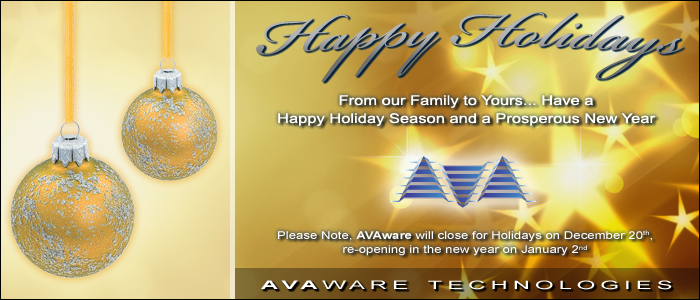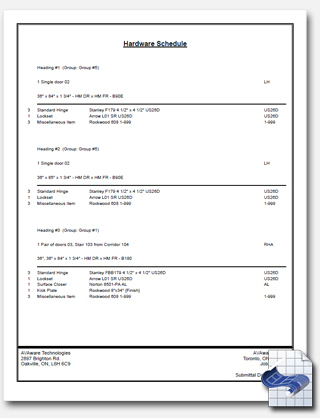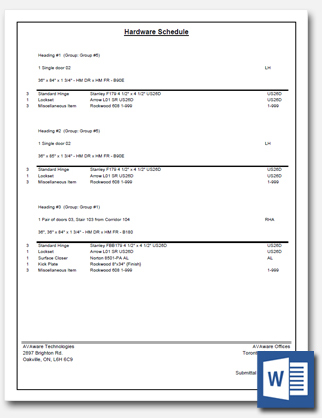
Happy Holidays from all of us at AVAware Technologies
Letter from the President
Santa Claus Goes “Higher” Tech – Thanks to Microsoft and Google
Create Perfectly Formatted MS Word Compatible Documents from AVAproject
Tip: Ensuring Your PC is Running Optimally

 U.S. Price Books: U.S. Price Books:
- Best
- Corbin-Russwin
- Falcon
- Ives
- LCN
- Rockwood
- Sargent
- Schlage
- Stanley Commerical
- Steelcraft
- Trimco
- Von Duprin
- Yale
 Canadian Price Books: Canadian Price Books:
- Canaropa
- Corbin-Russwin
- Ives
- LCN
- Sargent
- Schlage
- Stanley Commercial
|

|

|
|

|
|

|
|
|
From the Desk of the President
To Our Friends and Valued Customers,
Another year has passed. We’re all a bit older… perhaps greyer… hopefully wiser. Some would say the most important thing is that we’re all still here.
In recent years, when conversation becomes retrospective, most of us seem to recall the challenges that the industry and the economy as whole have experienced since the events of 2008. Happily 2013 brought with it the first real signs of recovery, and by all indications it was felt throughout the industry. For the first time in years, we saw companies renew their commitments to growth and even expansion – a welcome change from the anxiety that seemed to have encompassed everyone.
Periods of recovery bring with them hope; and along with it comes huge expectations for the years to come. Most people, upon finally seeing the “light at the end of the tunnel” look forward to something – revolutionary – something to look forward to. In this spirit our developers have spent the better part of 2013 working hard to develop the next evolution of our products; something that would exceed all expectations.
AVAware released a new version of its flagship product, AVAproject for 2013. In addition to another myriad of compelling new features, this version set the foundation for some exciting new technologies that will continue to develop into the next year.
Our Fusion product has continued to grow and develop as many new users have adopted the innovative platform and support continues grow for an increasing number of accounting/ERP systems. AVAware presently offers Fusion interface modules for several popular accounting systems, in addition to a development framework that allows quick development of additional modules as our users request them. It’s exciting to be able to offer our users choices; Fusion ensures that companies will never have to “settle” for anything less than the perfect solution for them.
On behalf of all of us at AVAware, we wish to thank our valued clients, vendors and corporate partners for all their past, present and ongoing support. We owe our success to you and only hope that we can, in some way, return the favor. From our family to yours, we wish to extend our best wishes for a safe and happy holiday season and a very prosperous new year.
All the best!

Paul S. Kirsch
President & CEO
AVAware Technologies
|
|
|

|
|
It seemed difficult to believe, but Santa Claus’ legal representatives – NORAD – had slighted the mighty Google in favor of an arrangement with Microsoft. In actuality, Microsoft had taken responsibility for setting up and maintaining the legendary NoradSanta.com site that allowed children all around the world to track the impending arrival of Father Christmas on his journey around the world.
You may recall that all this began when Sears & Roebuck offered a phone number in their Christmas advertising that could be used by parents to persuade anxious children to get to bed. As the story goes, they
|
published the wrong number and everyone ending up phoning the one-and-only NORAD! Mistake or not, It must have seemed perfectly reasonable in 1955 that NORAD, the organization once perceived as the most powerful and “all-seeing” on Earth, would be the ones capable of “tracking” even the magical Santa. Today, however, things may just have changed. Call it superior marketing skills, but if you ask most people today who the most powerful force on the planet is – their answers might be split between Google and Microsoft!
It’s fitting then that both of them should feel it’s their responsibility to “pick up the torch” as it were and continue this
|
long-standing American tradition. The problem is – at least for Google – that Microsoft seems to have won. NORAD has chosen Microsoft’s Bing Maps for their annual Santa tracker. It might be interesting to note (see the image below) that the actual Microsoft logo does not appear on the NORAD page; instead, a discreet “rethink” with the Micosoft Internet Explorer logo embedded appear in the top corner. Naturally, clicking on it takes users to the Internet Explorer page on the Microsoft web site. (image below)
|
|

|
|
Not to be outdone, Google’s team at Mountain View have taken it upon themselves to innovate Santa himself! Once again, they have set up their own version of the Santa trackers at Google.com/SantaTracker that, like the NORAD site, features a countdown, track on the all-important day as well as various games and toys to heighten the anticipation of children (and adults) everywhere.
This year, the battle for the hearts and minds of the children will also take
|
place in the mobile arena. While NORAD has released apps for both iOS and Android, Google has limited their offering to their Android platform. While it may seem that NORAD has one up their competitors, team Google has one more surprise – at least for a VERY small segment of the population.
Over the past year, Google has gradually rolled out early versions of their “Google Glass” product to a small, but growing number of early adopters. Select US residents that are willing to
|
cough up $1500 for the privilege can “request” the opportunity to buy into this well-publicized new technology. For those who have had the opportunity to do so, Google is offering a version of their Santa tracker that works on Google Glass! This is definitely what the “cool kids” are wearing this Christmas!

|
|
This is another powerful feature created in response to overwhelming requests from AVAproject users. In many markets, architects and other industry professionals have become accustomed to receiving reports such as Hardware Schedules in files compatible with such programs as Microsoft Word. By insisting on having files delivered in open formats such as this, architects enjoy the ability to modify reports they’ve been given at their leisure. Although many distributors and spec writers are often reluctant to provide editable files, given they’re far too easy for the customer to reuse on other jobs, sometimes one has no choice but to give them what they want.
Most people are familiar with common word processing programs, such as Microsoft Word, OpenOffice and Google Docs that save their documents to popular docx files. What most users don’t know is that these familiar docx files actually contain document data in XML format. During the “save” process, the XML data is ZIP-compressed and simply given their signature “docx” file extension.
|
Having had some experience in both creating XML formatted files, as well as ZIP compression (ie: AVAware’s online ‘Catalog Packager & Downloading tool’), AVAware developers were definitely up for the task.
AVAproject now contains a powerful docx export facility, which allows Word-compatible versions of the system’s text-based reports to be created. Unlike many other export tools, AVAproject’s offers several key features in the exported files:
- Each and every report-related option offered by AVAproject is reflected and supported in the Word export. Users will have complete control over the formatting of the schedules.
- Page titles and data blocks are exported as actual document ‘headers’ and ‘footers’ – not just free-floating text. This ensures that proper formatting will be automatically maintained should content be added or removed from the document after the fact.
|
- Columnar Schedules and reports are exported as actual document ‘tables’ – not just text delimited by spaces and tabs. Once again, perfect formatting will be maintained during manual editing.
- Standard document ‘properties’ are being set when the docx file is created. Attributes such as Project Name, Report Title, Plan Revision & Date, etc. are filled into their corresponding fields and can be seen when viewing file properties or browsing in a detail view. In addition, users that make use of document storage and retrieval systems (ie: Microsoft SharePoint) will be able to organize and search these fields based on the various attributes.
|
|

A Hardware Schedule as generated directly from AVAproject
|

A Hardware Schedule exported and printed from Microsoft Word
|
|
The image on the left is a ‘Hardware Schedule” as generated directly from AVAproject. The image on the right is the same document, exported to and printed from Microsoft Word.
It’s also important to note that this new export facility is entirely contained within AVAproject; as usual, absolutely no additional or third-party software packages are required for it to work – not even Microsoft Word!
When creating these, or any other XML based files, AVAware developers use our own proprietary software engine rather than rely on
|
the standard Microsoft-provided development tools. In general, we find we are able to realize an increase in performance by as much as 10x, while significantly reducing the overhead required. Even with all the additional formatting directives being added to the document files, AVAproject can export even the largest reports and schedules in a matter of seconds.
File Attributes
As a final measure of compatibility, AVAproject supports and sets the standard OS-readable file attributes
|
typical of Word documents. Right-clicking on an AVAproject-generated document file and selecting properties, will cause a dialog similar to this one to be shown. Notice that information such as ‘Project Name’ and other relevant information is inserted into the appropriate fields.
This information is also visible in “Detail” views of the Windows Explorer. Documents can be sorted and/or grouped by many of these fields.
|
This powerful new export tool is included as a standard feature of AVAproject since the September 2013 release.
|
|
|
Year end is an excellent time to catch up on the little chores that we all tend to procrastinate on throughout the year. One such task is the small bit of routine PC maintenance that can prevent a lot of headaches.
The following article is a favorite amongst our users and our staff alike. It was originally written for AVAwire by a senior AVAware developer and remains every bit as relevant and important today.
Before immersing yourself in a glass of holiday cheer, take a few minutes to ensure your trusty PC will be waiting for you in top condition next year.
|
|
|
* Originally published in the December 2011 AVAwire Newsletter *
|
Ensuring your PC is Running Optimally
|

|
As another year comes to a close, many businesses and individuals alike take advantage of the opportunity to do a bit of housekeeping to get ready for the new year. A tidy desk, clean work space and properly organized paperwork are all wonderful things to come back to after the holiday break to maximize productivity and efficiency. But what about your PC? The following are a few basic PC maintenance tips and tricks to ensure your computer is performing optimally.
|
|
Installed Programs
Throughout the year, many programs may be installed on a computer for a variety of reasons. These programs may include major business applications such as the AVAproject Suite, Microsoft Office, Adobe Acrobat, etc. These are examples of trusted applications that are likely among the most important applications installed. Other programs may be software that was installed for a specific isolated task such as file converters, download managers, registry cleaners, media players, support assistant applications or an endless number of system "utilities". There also may be applications that have been installed unintentionally or even secretly during the install process of other applications or through malicious web sites. These programs
|
may actually be set to run as background processes automatically when the computer is started, consuming system resources right from startup to shut down.
Clearly, it is important to be sure the computer's resources (processor, RAM, hard drive, etc.) are as available as they can be for the most important applications. This maximizes the speed at which these programs can perform and therefore provides the best possible user experience. Additionally, there is no easy way of telling what data malicious programs running in the background are collecting and where or to whom they are sending it.
For the reasons stated above, it is good practice to review the installed programs list once in a while and
|
remove anything that appears suspicious or is not recognized. The installed programs list can be found in the Control Panel under "Programs and Features" in Windows 7 (In earlier versions of Windows such as Windows XP, it is called "Add/Remove Programs"). "Free" Games and Toolbars are major offenders of installing additional software or reporting on usage data, searches, activity, etc. Simply think, if I were a software developer and spent months developing this application, how could I offer it for free?
|
NOTE: If unsure about a specific program, always consult your IT department and/or consultant. Removing important system tools or components may prevent software from running properly.
|
|
|
Startup Programs
The "Programs and Features" tool in the Control Panel lists software that was installed by a Windows Installer (a standard method of installing software). These programs, as mentioned previously, have an Uninstall capability. There are, however, other programs that do not offer an Uninstall process that may be running. To review and/or disable these programs, there is a little inconspicuous tool available called "System Configuration".
|
NOTE: This tool makes changes to the way the computer starts up. Use this tool at your own risk and with extreme caution. If in doubt, speak to your IT department or consultant.
|
|

The Windows System Configuration Utility, 'MSConfig'
|
|
To use the tool, use the "Run..." option in the Start Menu. When prompted, type "MSCONFIG" in the dialog and click "OK". Under the "Startup" Tab, software that is set to run when Windows is started is listed. Many of these entries will be legitimate and necessary, but with a discriminating eye one can spot the problem software.
|
Look for items that do not have a manufacturer listed, a bizarre or unreadable name or no name at all. Also examine the "Command" path to be sure the program and its function are recognized and trusted.
To disable an item, uncheck the "Startup Item" and click "Apply". When finished, click "OK". The System
|
Configuration tool will ask to reboot the computer, as the programs that have been set to be disabled are still currently running. Once the system has rebooted, a small dialog will be shown as a notification that the startup configuration has been changed.
|
|
Temporary Files
Temporary files are a major contributor to problems with disk space. On computers that are rarely cleaned up, there are often many gigabytes of disk space being occupied by temporary files such as downloaded application installers and locally cached web sites. These files are not important to the proper function of the system, however there are some cases where it may be desirable to make backups of certain temporary files. AVAproject, for instance, saves copies of project files in temporary directories as backups in case of system failure or file corruption (if the "Auto-Save" feature is enabled).
|
NOTE: If AVAproject's "Auto-Save" feature is enabled, the saved copies of project files can be accessed by opening AVAproject and selecting the "Open from TEMP Directory" option from the "Help" menu.
|
|
To remove temporary files from your system, Windows offers a very simple tool called "Disk Cleanup" and can be found in the Start Menu under "All Programs" / "Accessories" / "System Tools". With this tool, simply select the drive to clean up (typically "C:" - the system drive) and click "OK". The tool will look in all of the various places temporary files are saved and present a list of options and areas to clean. Again, removing any or all of these files should not negatively affect any of your programs, but if in doubt, always talk to your IT department or consultant.
Browser Add-Ons
Browser add-ons are small programs that run inside of web browsers such as Internet Explorer, Firefox, Chrome and many more. Often they cause the browser to run slower than usual, and in some cases also pose a security risk
|
by reporting usage data and tracking activity and search terms back to the developers of the add-on.
As with installed programs, some of these add-ons were likely installed intentionally such as the Adobe Acrobat Reader which allows PDF files from web sites to be displayed in the browser. Other add-ons may have been installed unintentionally or maliciously.
To review and/or disable browser add-ons in Internet Explorer, under the "Tools" icon, click "Manage Add-Ons". There is very little risk of causing any problems to your system by disabling browser add-ons, so if your browser is sluggish, it's quite acceptable to disable all add-ons and selectively re-enable desired items until the major culprit is identified.

|
|

|
Windows Update
|
Virtually every piece of software will inevitably have updates made to it. These “updates” can be for a number of reasons, ranging from new feature to addressing “bug” issues and security threats. Though often overlooked, the same holds true for the operating system itself. Microsoft also releases regular updates to Windows for all the same reasons.
If Windows (and other Microsoft software) is not current with the latest bug fixes and patches, your system is vulnerable to viruses, spyware and other malicious software. Windows
|
Update is a built-in software download and installation system for keeping Windows and other Microsoft products up to date. Windows Update not only ensures the latest operating system and program features are available, but also provides the latest bug fixes and security vulnerability patches that are critical for system safety. The software updates come directly from Microsoft and may be trusted for installation.
In the Windows Update preferences the system administrator can set whether Windows Update should download and install updates automatically, simply download the updates and wait to be instructed to install them, or neither download nor install updates. If the second or third option is selected,
|
respectively, it is extremely important that the user manually install the latest Windows updates on a regular basis.
Many malicious software preys on “un-patched” computers, as the vulnerabilities they exploit are often already patched via Windows Update. We recommend downloading and installing updates automatically if possible, since it keeps the operating system and software up to date constantly and provides the best protection against the latest threats.
To change preferences and/or install updates, simply locate and run “Windows Update” in the “All Programs” section of the Start Menu.
|
|
As a final note, it is always advisable to be using anti-virus / anti-malware software to protect your computer from malicious programs. Some of the traditional anti-virus suites actually consume a lot of system resources in their own right, which may be bogging your computer down. Microsoft offers their own (free) program to combat malicious software called Microsoft Security Essentials. We have found it to be very light-weight in terms of the required system resources and just as effective as other commercial solutions.
|
|
We welcome any questions, comments or suggestions about any topic mentioned in this edition of AVAwire. Please visit our website for more information, or contact us directly at (416) 239-9099.
|
|